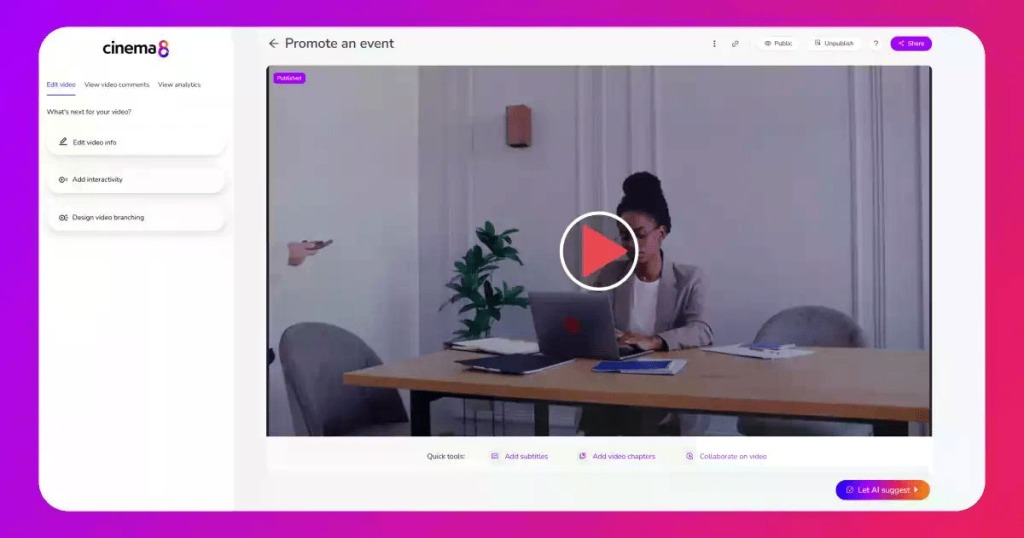
Gaming and esports have always thrived on participation, but until recently, watching matches or streams offered limited ways for audiences to influence what unfolded on screen. Viewers could watch, post reactions in chat, and subscribe, yet the interaction often ended there. With interactive video hosting, the gap between player and audience is narrowing. Gamers, esports professionals, and content creators can now turn streams into dynamic, two-way experiences that keep audiences involved for longer.
The rise of interactive video in gaming
Interactive video adds a new dimension to gaming content. By integrating clickable elements, branching storylines, and real-time prompts, creators can transform streams into participatory events where audiences have a say in what happens next. These tools not only make streams more engaging but also encourage viewers to return because their input genuinely shapes the experience.
The first major change is the shift from simple observation to active involvement. This transformation turns audiences into participants who can directly influence the flow of the game or content.
From one-way watching to active participation
In traditional streaming, audiences act as spectators with limited influence over the action on screen. Interactive features shift this dynamic by allowing viewers to make decisions, vote on in-game outcomes, or unlock bonus content while the stream unfolds. For example, a creator hosting a “choose your own path” RPG can present viewers with multiple options, with the majority vote determining the character’s next move. This creates a stronger sense of connection, making the experience more personal for each participant.
The second change lies in how livestreams hold audience attention from start to finish. Real-time tools give viewers ongoing reasons to engage rather than simply watch without interaction.
Enhancing livestreams with real-time interaction
Live polls, clickable overlays, and in-stream challenges give creators more ways to hold attention. A competitive fighting game streamer might run quick polls between matches to let viewers select the next character, while an FPS streamer could trigger unique challenges when donation goals are met. Real-time interaction keeps the audience invested, builds momentum during slower moments, and fosters a sense of shared achievement between the streamer and their viewers.
These same interactive techniques are proving even more valuable in the fast-paced arena of esports. By bringing fans closer to the action and giving them a role in shaping the experience, interactive hosting is redefining how competitive gaming is presented and consumed.
How esports benefits from interactive hosting
Esports thrives on community involvement, and interactive hosting strengthens that bond. Tournaments and leagues depend on engaged audiences, and by making viewers part of the action, teams and organisers can cultivate loyalty that lasts beyond a single event.
Two of the most effective ways to achieve this are by giving fans direct opportunities to participate during matches and by weaving narratives that make every game feel like part of a larger story.
Driving fan engagement through polls and quizzes
Esports matches offer many opportunities for fans to contribute. Viewers can predict match outcomes, vote for the most valuable player, or answer trivia about the game’s mechanics. These elements can run alongside the gameplay without disrupting the main viewing experience. For instance, during a MOBA tournament, a poll predicting the next major team fight outcome can run live, adding another layer of anticipation. The interactivity keeps fans focused even during pauses in the action and makes them feel more connected to the competition.
Creating immersive storylines
Interactive hosting also allows teams, casters, and creators to craft story-driven experiences that extend beyond the scoreboard. Supplemental content, player profiles, and interactive highlight reels can be linked within the stream for viewers to explore at their own pace. In a fighting game league, for example, fans could click through to watch curated clips of a player’s most iconic wins or learn about their training journey. This storytelling deepens emotional investment, making audiences care about the people behind the gameplay.
Security and fair play in gaming streams
With greater interactivity comes a greater need for strong safeguards, especially in competitive environments where a single disruption can affect outcomes and reputations. High-profile esports events have faced challenges such as unauthorised overlays, malicious polls, and stream sniping, all of which can undermine fair play and audience trust. Without the right protections, interactive features risk becoming vulnerabilities rather than enhancements.
A secure interactive platform can prevent these scenarios by encrypting overlays so they cannot be altered, gating specific features behind verified logins, and giving organisers control over who can trigger interactive elements during a stream. In a MOBA finals event, this could mean fans can vote on “player of the match” without the risk of in-game disruption. For an individual streamer, it might mean running donation-triggered challenges while keeping their game feed free from delay-sensitive leaks.
For events that attract international audiences, these protections also safeguard against region-specific cyberattacks that target vulnerable streaming infrastructure. Organisers can confidently allow interactive trivia rounds, scavenger hunts, or mini-games between matches knowing that only authorised viewers can participate. This not only maintains competitive integrity but also reassures sponsors and partners that their brand is showcased in a secure, well-managed environment. With the right security in place, interactivity becomes an asset rather than a liability.
The future of interactive video in competitive gaming
As technology continues to advance, interactive video is set to become a core feature in both casual gaming streams and professional esports events. Expect deeper integration of real-time decision-making tools, more personalised viewing options, and analytics that help creators understand exactly how audiences engage.
These developments will do more than enhance entertainment value. They will reshape how games are streamed, how audiences participate, and how communities form around competitive play. Spectators will increasingly become contributors, influencing outcomes, exploring extra content, and staying connected before, during, and after the main event.
Platforms such as Cinema8 make it possible to combine interactivity, analytics, and secure hosting in one streamlined system. By pairing creative content with reliable technology, gaming and esports organisations can set new expectations for what it means to watch and play together. Advanced features like in-stream branching paths and clickable overlays keep audiences engaged longer, while real-time data allows organisers to adapt content on the fly. Secure delivery ensures that interactive elements remain tamper-proof, protecting both competitive integrity and viewer trust. The result is a high-impact viewing experience that benefits players, organisers, and audiences alike.






















